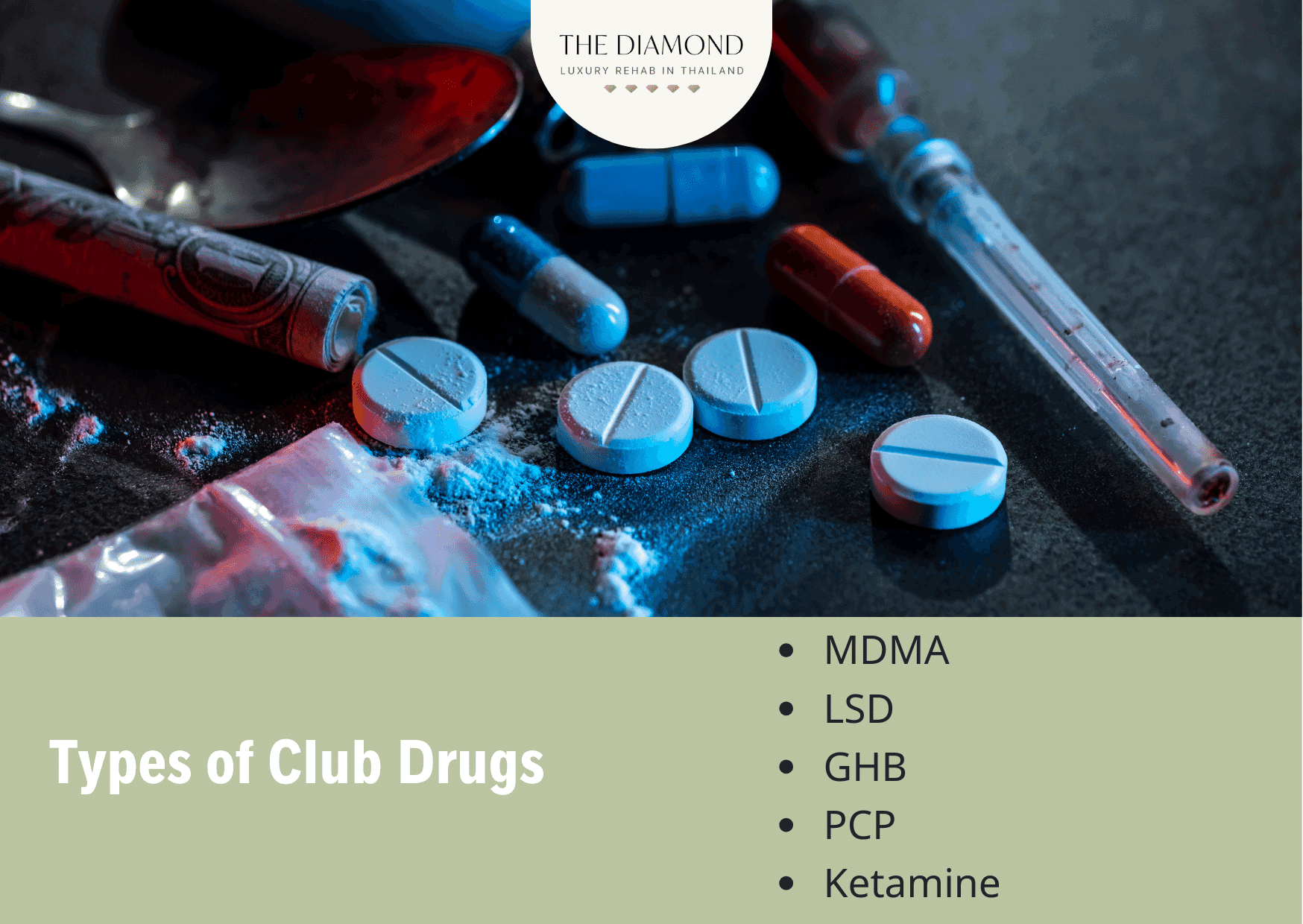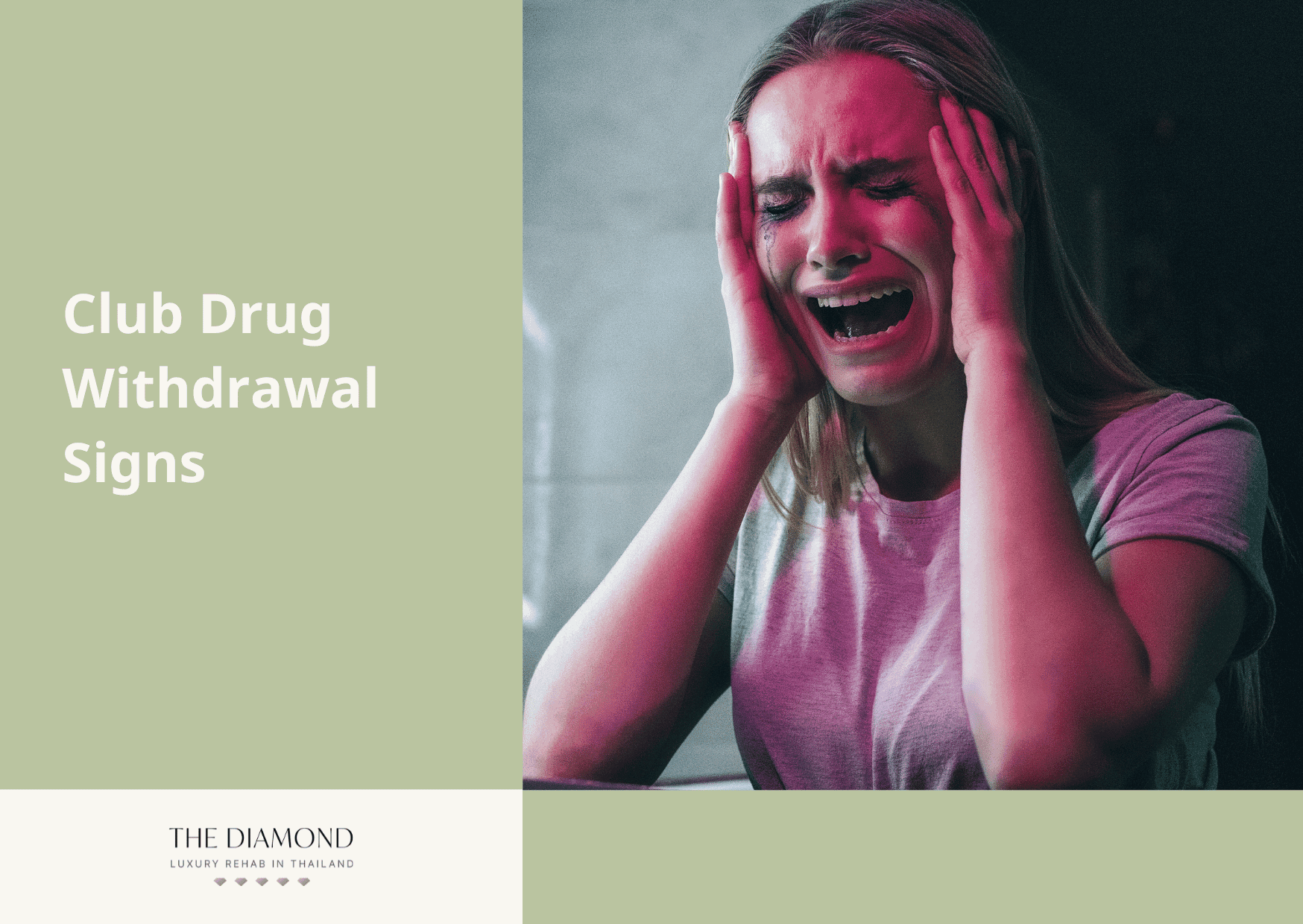Club drugs: What you should know?

Club drugs are illicit substances used at parties, raves, or concerts to distort perception and enhance mood. These substances have been used for decades, since the 1970s disco era. Over the years people used different club drugs, but what they all have in common is a strong influence on the brain’s functions.
People use club drugs to detach themselves from reality and enhance the experience at a festival, rave, or other occasions. Many people also use club drugs to engage in risky and violent behaviors, including sexual assault and rape.
The causes of club drug abuse include the rewarding effects of the substance in the brain, a family history of substance abuse, social influence, stress, emotional difficulties, and co-occurring mental health problems.
Club drugs have a strong impact on the brain, heart, kidneys, and overall psychological and physical health and wellbeing. The exact side effects of club drugs depend on the type of the substance.
The most common types of club drugs include ecstasy, angel dust, roofies, and LSD, among others. In most cases, these drugs are in the form of a tablet or capsule, powder, or liquid.
Club drugs also go by many names depending on the type of the substance. Besides the abovementioned, other names include molly, meth and acid, liquid ecstasy, special K, and ice.
Although there are many different types of club drugs, you can identify them with the aid of some common indicators. Usually available in pill or powder form, these drugs can also be supplied with eye-catching creative logos or vibrant colors.
What are Club drugs?
Club drugs, also known as party drugs, rave drugs, and fun drugs, are psychoactive drugs that people use recreationally during parties, concerts, raves, or in bars and clubs.
Club drugs were first associated with discotheques in the 1970s, but they’re used today as well. People use club drugs to improve their mood and change their perception of reality and senses. Club drugs are illegal and have addictive potential, and their side effects can be severe.

What are the causes of Club drug abuse?
The causes of club drug abuse can be biological, psychological, or environmental. Substances of abuse, including club drugs, act on the brain’s reward system by triggering the release of dopamine. That makes a person experience satisfaction, euphoria, and relaxation, depending on the nature of the drug. These effects are short-term, however.
For that reason, a person needs to use more drugs to experience the same effects. With continued use, dopamine receptors weaken so it’s necessary to use it more frequently or at higher doses. This leads to abuse and eventually addiction.
Other causes of club drug abuse include a family history of drug and alcohol abuse or socializing with people who also do the same. Existing mental health problems or stress and frustration can also propel club drug abuse.
What are the effects of Club drugs?
The effects of club drugs can impact the brain, body, and self-control, and may include impaired senses, poor memory, judgment, and coordination, as well as loss of muscle control, increased heart rate, aggression, and violent behaviors. Long-term effects of club drugs, like other substances, include the damage of neurons or brain cells.
Most people take them to experience the energy boost and alter their perception of reality. At the same time, club drugs’ effects on the body range from loss of motor and muscle control, and blurred vision.
Sometimes, club drugs also induce seizures, increase blood pressure, cause gastrointestinal disturbances, speed up heart rate, and contribute to heart and kidney failure. Club drugs may also lead to involuntary teeth clenching, nausea, sweating or chills, reduced reaction time, aggression and violent behaviors, and hallucinations, according to an article titled, “Club Drugs (Ecstasy, Herbal Ecstasy, Rohypnol, GHB, Ketamine)” from NYC Health.
Some club drugs have sedating effects meaning they practically immobilize a person to make them lose consciousness. Users generally don’t remember anything that happened when under the influence. For that reason, some of these substances are used as date-rape drugs.

What are the risk factors for club drug abuse?
Risk factors for club drug abuse may explain who is more likely to use these substances and develop potential complications. The risk factors for club drug abuse are listed below.
- Drinking alcohol or using other drugs/substances
- Young age (adolescence or young adulthood)
- Family history of drug use
- Dysfunctional family environment
- Socializing with people who use club drugs
- Frequently partying in clubs and at raves
- History of mental health problems
While everyone can use club drugs, some people are more likely to do so. Other risk factors of club drug abuse include :
- Social factors
- Family life and history
- Lifestyle
- Age

What are the different types of Club drugs?
Different types of club drugs refer to various psychoactive substances commonly used in social and nightlife settings, such as clubs, parties, and music festivals. The different types of club drugs are listed below.
- Methylenedioxymethamphetamine (MDMA): also known as ecstasy or molly, is a synthetic drug that changes a person’s mood and perception, i.e. awareness of conditions and objects in the surrounding. Since MDMA is chemically similar to hallucinogens and stimulants alike, it induces feelings of heightened pleasure, energy, and distorted perception, according to a 2020 article titled, “MDMA (Ecstasy/Molly) DrugFacts” from the National Institute on Drug Abuse. People use MDMA in tablet or capsule form, but some of them snort the powder or take it in liquid form. According to 2023 data on the number of Americans who used ecstasy (MDMA) in the past year 2009-2021 published in Statista, in 2020, around 2.6 million people in the U.S. reported MDMA use in the past year.
- Lysergic acid diethylamide (LSD): also known as acid, this drug is a classical hallucinogen. People have been abusing LSD since the 1960s, and it is one of the most frequently used club drugs. Delusions and visual hallucinations are the effects of LSD use. This drug can distort a person’s sense of identity and time. People use LSD in tablet, capsule, or liquid form.
- Gamma-hydroxybutyrate (GHB): also known as Xyrem, G, and liquid ecstasy. The fact sheet on GHB – Gamma-Hydroxybutyric Acid published by the U.S. Drug Enforcement Administration (DEA) reports that GHB is also referred to as a date-rape drug. It comes in a liquid form or as a white powder that is dissolved in alcohol, water, or juice. It’s useful to mention Xyrem is a central nervous system depressant and may be prescribed (rarely) to treat a sleep disorder called narcolepsy.
- Phencyclidine (PCP): also known as angel dust, elephant tranquilizer, lovely, crystal, and hog, PCP is a hallucinogenic that induces feelings of euphoria, strength, omnipotence, and sexual power.
- Ketamine: also known as K and special K, is an anesthetic with hallucinogenic properties and a derivative of PCP. The use of this drug can distort the perception of sound and sight. Ketamine makes users feel disconnected from reality or like they’re losing control. For that reason, ketamine is referred to as a dissociative anesthetic. It appears as a clear liquid or white and off-white powder.
- Rohypnol: also known as roofies, belongs to a class of drugs called benzodiazepines. In many countries, roofies (flunitrazepam) are used to treat insomnia or as an anesthetic. However, in the U.S. roofies aren’t approved for prescription use. Like GHB, roofies are also used as date-rape drugs. It is odorless, tasteless, and colorless and it can be taken as a tablet or dissolved in water. Roofies are also known as forget-me pills, Mexican Valium, rope, wolfies, and other names.
- Methamphetamine: also known as meth, ice, or speed, is a potent and highly addictive stimulant that acts on the central nervous system. People use meth by smoking, swallowing, snorting, or injecting the powder that has been dissolved in alcohol or water.
Other different types of club drugs include:
- Date rape drugs
- Perception-altering drugs y
- Mood-altering drugs
People at raves tend to use ecstasy primarily, as well as LSD and GHB. Unfortunately, the use of date-rape drugs is particularly common in clubs or raves. Generally speaking, people at raves use any kind of drug that may enhance their energy, endurance, sexual arousal, sociability, and experience at the party.
Who uses Club drugs?
Club drugs are generally used by teens or young adults at nightclubs, raves, concerts, bars, and parties in order to reduce inhibitions and heighten sensory perceptions. A study by Kelly et al., published in the September 2006 issue of the Journal of Urban Health confirms that club-going populations are most likely to use these drugs.
Men are more likely to use club drugs than women. The frequency of use of these drugs varies in terms of sexual orientation. For example, LSD was more prevalent in heterosexual males while methamphetamines are more frequently used by gay and homosexual men, according to a 2009 study by Parsons et al., published in the Public Health Reports.
Persons who drink alcohol or use other illicit substances are also more likely to choose club drugs in some situations.

What are the signs of Club drug withdrawal?
Signs of club drug withdrawal vary from one specific drug to another. The withdrawal signs for each individual club drug are listed below.
- MDMA: Withdrawal symptoms usually include fatigue, loss of appetite, difficulty concentrating, and depression. The formal timeline of withdrawal symptoms linked to MDMA use is not established.
- LSD: Withdrawal symptoms include malaise and dissociation. However, there is no withdrawal profile for LSD or a specific timeline.
- GHB: Withdrawal symptoms occur in several stages. The early acute withdrawal phase starts within 24 hours after cessation of heavy use. Patients tend to experience severe intermittent tachycardia, insomnia, nausea and vomiting, anxiety, confusion, delirium, hypertension, and sweating. During the next six days, symptoms change progressively.
- PCP: Withdrawal symptoms that occur within eight hours after the last use include agitation, fear, anxiety, restlessness, irritability, headache, sweating, higher body temperature, seizures, hallucinations, diarrhea, and muscle twitching. PCP use can have long-term withdrawal symptoms too and they include depression, mood disorders, suicidal thoughts, impaired cognitive abilities, sleep problems, and weight loss.
- Ketamine: Common withdrawal symptoms include loss of motivation, depressed mood, and longer malaise period, but no formal withdrawal timeline is established.
- Roofies: Withdrawal occurs in two phases called acute withdrawal and protracted withdrawal. Acute withdrawal occurs within three to four days after the last use of the drug. In most cases, a person experiences symptoms linked to anxiety and this is referred to as rebound anxiety. Rebound anxiety can cause cravings, higher blood pressure, flu-like symptoms, faster heart rate, nausea and vomiting, difficulty sleeping, and insomnia. Protracted withdrawal takes place after acute withdrawal and it lasts between 10 and 14 days. In this phase, patients may experience shakiness, nausea and vomiting, cravings, anxiety, and depression.
- Meth: The most common withdrawal symptoms include extreme cravings for the drug, lethargy and fatigue, nervousness, increased appetite, depression, and psychotic symptoms such as paranoia, hallucinations, and delusions. Withdrawal occurs quickly after cessation of use due to the short half-life of methamphetamine. Symptoms of withdrawal tend to appear within 24 hours after the first use, peak in four to 10 days, and their average duration is two to three weeks.
What is the treatment for Club drug abuse?
The treatment for club drug abuse primarily revolves around therapy. The most effective therapies are cognitive-behavioral therapy (CBT) and contingency management.
The main objective of CBT is to help users of club drugs identify negative thoughts, behaviors, and other stimuli that make them want to use these drugs. Once they do so, the therapist helps them adopt healthier coping mechanisms so they can avoid club drug use and prevent relapse.
Contingency management, on the other hand, involves the use of incentives such as vouchers to motivate and encourage patients to stop using club drugs and remain drug-free. Treatment of club drug abuse also indicates a person should stop using other substances. For example, they need to stop using alcohol to reduce their withdrawal symptoms.
Support groups are also helpful for persons who abuse club drugs. They work because people with the same problem get to talk about their experiences and thereby offer and receive support and encouragement.
Are Club drugs dangerous?
Yes, club drugs are dangerous due to the disastrous effects they can cause. The dangers of club drugs depend on the specific substance. These drugs can induce changes in mood and awareness, thereby enabling people to feel more social and less inhibited.
Impaired judgment and other effects of club drugs can lead to violence, self-harm, engaging in risky behaviors, serious health consequences, and even overdose, coma, and death. Some of these drugs also increase the risk of sexual assault and rape.
In other words, club drugs can put users and people around them in danger alike. Many people take club drugs with other substances, such as alcohol. In these cases, the risk of side effects and complications or potential dangers increases significantly.

